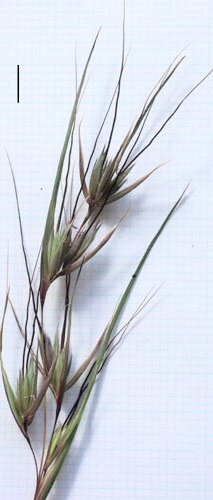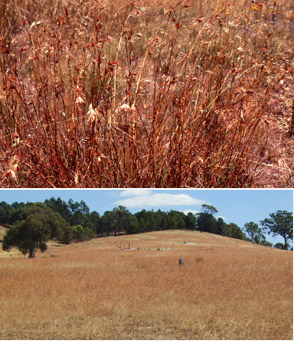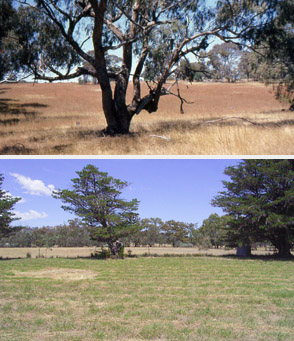Kangaroo Grass - native (Themeda triandra)




Native to Australia and Africa. Perennial. C4.
Family. Poaceae (Grass family).
Identification
- the flower clusters are leafy sprays
- the flowers have sterile and fertile florets
- the fertile florets are long-awned
- the leaves are flat
- the ligule is minutely fringed, 0.3-1mm long.
Kangaroo Grass is a distinctive and easily recognised grass.
The flower cluster of Kangaroo Grass is made up of smaller clusters, each of which is partly covered by a floral leaf (spathe). These smaller clusters have sterile and fertile spikelets. The fertile lemma is continuous with a stout, long, (eventually) twice-bent awn.
Kangaroo Grass is an iconic Australian grass. However, it is also native to the Middle East and Africa. It was first named in 1775 in the Flora of Egypt and Arabia. In Africa it is known as Red Oat-grass. N.S.W. botanists consider Kangaroo Grass to be sufficiently different from the African form to be considered a separate species, called Themeda australis. So in N.S.W. it is a species restricted to Australia.
Kangaroo Grass is uncommon in forest, but is common in grasslands where it may dominate.
themed or thaemed: an Arabic word for this grass; australis: southern.
Central column 1: Dense Kangaroo Grass. Kalimna Reserve, Castlemaine. 2: Kangaroo Grass covered hillside. North of the Maldon Railway. 3: Paddock with Kangaroo Grass. Sutton Grange. 4: Mown Kangaroo Grass. Moonambel Cemetery. Kangaroo Grass remains green well after most introduced grasses have dried off.
Right: 5: Spikelets with surrounding spikelets removed. The second glume is on the left. 6: Flower clusters are partly covered by a leaf. The long-awned florets are fertile. The outer florets are sterile. The central floret is fertile and long-awned.
The summer colour of Australian landscapes is said to be golden, but if there is Kangaroo Grass the colour is brown.